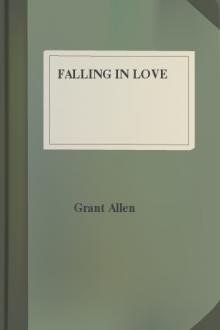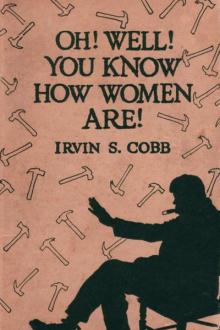Falling in Love by Grant Allen (different e readers .txt) 📕

- Author: Grant Allen
- Performer: -
Book online «Falling in Love by Grant Allen (different e readers .txt) 📕». Author Grant Allen
How can I make this confident assertion, you ask, about a gentleman whom I never personally saw, and whose habits the intervention of five hundred centuries has precluded me from studying at close quarters? At first sight, you would suppose the evidence on such a point must be purely negative. The reconstructive historian must surely be inventing à priori facts, evolved, more Germanico, from his inner consciousness. Not so. See how clever modern archæology has become! I base my assertion upon solid evidence. I know that Primitive Man was ambidextrous, because he wrote and painted just as often with his left as with his right, and just as successfully.
This seems once more a hazardous statement to make about a remote ancestor, in the age before the great glacial epoch had furrowed the mountains of Northern Europe; but, nevertheless, it is strictly true and strictly demonstrable. Just try, as you read, to draw with the forefinger and thumb of your right hand an imaginary human profile on the page on which these words are printed. Do you observe that (unless you are an artist, and therefore sophisticated) you naturally and instinctively draw it with the face turned towards your left shoulder? Try now to draw it with the profile to the right, and you will find it requires a far greater effort of the thumb and fingers. The hand moves of its own accord from without inward, not from within outward. Then, again, draw with your left thumb and forefinger another imaginary profile, and you will find, for the same reason, that the face in this case looks rightward. Existing savages, and our own young children, whenever they draw a figure in profile, be it of man or beast, with their right hand, draw it almost always with the face or head turned to the left, in accordance with this natural human instinct. Their doing so is a test of their perfect right-handedness.
But Primitive Man, or at any rate the most primitive men we know personally, the carvers of the figures from the French bone-caves, drew men and beasts, on bone or mammoth-tusk, turned either way indiscriminately. The inference is obvious. They must have been ambidextrous. Only ambidextrous people draw so at the present day; and indeed to scrape a figure otherwise with a sharp flint on a piece of bone or tooth or mammoth-tusk would, even for a practised hand, be comparatively difficult.
I have begun my consideration of rights and lefts with this one very clear historical datum, because it is interesting to be able to say with tolerable certainty that there really was a period in our life as a species when man in the lump was ambidextrous. Why and how did he become otherwise? This question is not only of importance in itself, as helping to explain the origin and source of man's supremacy in nature—his tool-using faculty—but it is also of interest from the light it casts on that fallacy of poor Charles Reade's already alluded to—that we ought all of us in this respect to hark back to the condition of savages. I think when we have seen the reasons which make civilised man now right-handed, we shall also see why it would be highly undesirable for him to return, after so many ages of practice, to the condition of his undeveloped stone-age ancestors.
The very beginning of our modern right-handedness goes back, indeed, to the most primitive savagery. Why did one hand ever come to be different in use and function from another? The answer is, because man, in spite of all appearances to the contrary, is really one-sided. Externally, indeed, his congenital one-sidedness doesn't show: but it shows internally. We all of us know, in spite of Sganarelle's assertion to the contrary, that the apex of the heart inclines to the left side, and that the liver and other internal organs show a generous disregard for strict and formal symmetry. In this irregular distribution of those human organs which polite society agrees to ignore, we get the clue to the irregularity of right and left in the human arm, and finally even the particular direction of the printed letters now before you.
For primitive man did not belong to polite society. His manners were strikingly deficient in that repose which stamps the caste of Vere de Vere. When primitive man felt the tender passion steal over his soul, he lay in wait in the hush for the Phyllis or Daphne whose charms had inspired his heart with young desire; and when she passed his hiding-place, in maiden meditation, fancy free, he felled her with a club, caught her tight by the hair of her head, and dragged her off in triumph to his cave or his rock-shelter. (Marriage by capture, the learned call this simple mode of primeval courtship.) When he found some Strephon or Damœtas rival him in the affections of the dusky sex, he and that rival fought the matter out like two bulls in a field; and the victor and his Phyllis supped that evening off the roasted remains of the vanquished suitor. I don't say these habits and manners were pretty; but they were the custom of the time, and there's no good denying them.
Now, Primitive Man, being thus by nature a fighting animal, fought for the most part at first with his great canine teeth, his nails, and his fists; till in process of time he added to these early and natural weapons the further persuasions of a club or shillelagh. He also fought, as Darwin has very conclusively shown, in the main for the possession of the ladies of his kind, against other members of his own sex and species. And if you fight, you soon learn to protect the most exposed and vulnerable portion of your body; or, if you don't, natural selection manages it for you, by killing you off as an immediate consequence. To the boxer, wrestler, or hand-to-hand combatant, that most vulnerable portion is undoubtedly the heart. A hard blow, well delivered on the left breast, will easily kill, or at any rate stun, even a very strong man. Hence, from a very early period, men have used the right hand to fight with, and have employed the left arm chiefly to cover the heart and to parry a blow aimed at that specially vulnerable region. And when weapons of offence and defence supersede mere fists and teeth, it is the right hand that grasps the spear or sword, while the left holds over the heart for defence the shield or buckler.
From this simple origin, then, the whole vast difference of right and left in civilised life takes its beginning. At first, no doubt, the superiority of the right hand was only felt in the matter of fighting. But that alone gave it a distinct pull, and paved the way, at last, for its supremacy elsewhere. For when weapons came into use, the habitual employment of the right hand to grasp the spear, sword, or knife made the nerves and muscles of the right side far more obedient to the control of the will than those of the left. The dexterity thus acquired by the right—see how the very word 'dexterity' implies this fact—made it more natural for the early hunter and artificer to employ the same hand preferentially in the manufacture of flint hatchets, bows and arrows, and in all the other manifold activities of savage life. It was the hand with which he grasped his weapon; it was therefore the hand with which he chipped it. To the very end, however, the right hand remains especially 'the hand in which you hold your knife;' and that is exactly how our own children to this day decide the question which is which, when they begin to know their right hand from their left for practical purposes.
A difference like this, once set up, implies thereafter innumerable other differences which naturally flow from it. Some of them are extremely remote and derivative. Take, for example, the case of writing and printing. Why do these run from left to right? At first sight such a practice seems clearly contrary to the instinctive tendency I noticed above—the tendency to draw from right to left, in accordance with the natural sweep of the hand and arm. And, indeed, it is a fact that all early writing habitually took the opposite direction from that which is now universal in western countries. Every schoolboy knows, for instance (or at least he would if he came up to the proper Macaulay standard), that Hebrew is written from right to left, and that each book begins at the wrong cover. The reason is that words, and letters, and hieroglyphics were originally carved, scratched, or incised, instead of being written with coloured ink, and the hand was thus allowed to follow its natural bent, and to proceed, as we all do in naïve drawing, with a free curve from the right leftward.
Nevertheless, the very same fact—that we use the right hand alone in writing—made the letters run the opposite way in the end; and the change was due to the use of ink and other pigments for staining papyrus, parchment, or paper. If the hand in this case moved from right to left it would of course smear what it had already written; and to prevent such untidy smudging of the words, the order of writing was reversed from left rightward. The use of wax tablets also, no doubt, helped forward the revolution, for in this case, too, the hand would cover and rub out the words written.
The strict dependence of writing, indeed, upon the material employed is nowhere better shown than in the case of the Assyrian cuneiform inscriptions. The ordinary substitute for cream-laid note in the Euphrates valley in its palmy days was a clay or terra-cotta tablet, on which the words to be recorded—usually a deed of sale or something of the sort—were impressed while it was wet and then baked in, solid. And the method of impressing them was very simple; the workman merely pressed the end of his graver or wedge into the moist clay, thus giving rise to triangular marks which were arranged in the shapes of various letters. When alabaster, or any other hard material, was substituted for clay, the sculptor imitated these natural dabs or triangular imprints; and that was the origin of those mysterious and very learned-looking cuneiforms. This, I admit, is a palpable digression; but inasmuch as it throws an indirect light on the simple reasons which sometimes bring about great results, I hold it not wholly alien to the present serious philosophical inquiry.
Printing, in turn, necessarily follows the rule of writing, so that in fact the order of letters and words on this page depends ultimately upon the remote fact that primitive man had to use his right hand to deliver a blow, and his left to parry, or to guard his heart.
Some curious and hardly noticeable results flow once more from this order of writing from left to right. You will find, if you watch yourself closely, that in examining a landscape, or the view from a hill-top, your eye naturally ranges from left to right; and that you begin your survey, as you would begin reading a page of print, from the left-hand corner. Apparently, the now almost instinctive act of reading (for Dogberry was right after all, for the civilised infant) has accustomed our eyes to this particular movement, and has made it especially natural when we are trying to 'read' or take in at a glance the meaning of any complex and varied total.
In the matter of pictures, I notice, the correlation has even gone a step farther. Not only do we usually take in the episodes of a painting from left to





Comments (0)